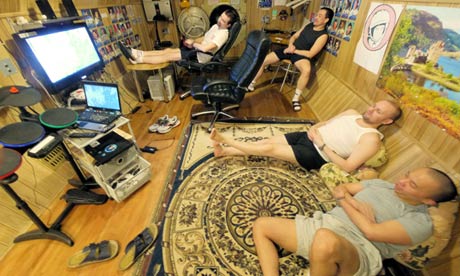Trip to Mars in pretend spaceship on Moscow industrial estate affects sleep, activity levels and motivation of six-man crew


Members of the Mars500 crew relax on the fake spaceship in Moscow. Photograph: AFP
As the cheerless skies and grim economy sap all will to return to work, take heart that even on a trip to Mars, it is hard to get out of bed in the morning.
The drudge of interplanetary travel has emerged from research on six men who joined the longest simulated space mission ever: a 17-month round trip to the red planet in a pretend spaceship housed at a Moscow industrial estate.
Though chosen for the job as the best of the best, the would-be spacefarers spent more and more time under their duvets and sitting around idle as the mission wore on. The crew's activity levels plummeted in the first three months, and continued to fall for the next year.
On the return leg, the men spent nearly 700 hours longer in bed than on the outward journey, and only perked up in the last 20 days before theyclambered from their capsule in November 2011. Four crew members suffered from sleep or psychological issues.
"We saw some problems," said Mathias Basner, of the University of Pennsylvania, who studies the effects of sleep-loss on behaviour. "There were no major adverse events, but there could have been if the stars were aligned in a certain way."
The $10m (£6.2m) Mars500 project, run by the European Space Agency (ESA) and the Russian Institute for Biomedical Problems, launched, metaphorically, when the hatch to the mock-up spaceship closed behind three Russians, two Europeans and a Chinese man in June 2010. The men spent the next 520 days in windowless isolation. Their only contact with the outside world was over the internet and by phone lines that carried a delay of up to 20 minutes, to mimic the time it takes radio waves to reach Mars from Earth.
Throughout the mission, the men endured daily medical, physical and psychological examinations, to help space agencies learn how humans cope with the stress, confinement and limited company that astronauts will face on future voyages. The crew fought boredom by watching DVDs, reading books and playing Guitar Hero on a games console. Mission controllers faked a fire and a power outage to keep them alert.
The ESA selected the crew from thousands of highly qualified applicants, and put them through a year of intensive training. But despite embodying "the right stuff" that underpins the astronaut corps, the men struggled with the tedium of the mission.
"The monotony of going to Mars and coming back again is something that will need to be addressed in the future. You don't want your crew hanging around doing nothing," Basner said.
On a real mission, sedentary astronauts would be at greater risk of bone and muscle wastage.
According to the study, published in Proceedings of the National Academy of Sciences, some crew members fared worse than others. One began living a 25-hour day, and quickly fell out of routine with the others. "If you live on a 25-hour day, after twelve days it's the middle of the night for you when it's daytime for everyone else," Basner said.
Another crew member slept at night but took ever longer naps during the day. Taken together, the two men spent a fifth of their time, or 2,500 hours, asleep when the rest of the crew were awake, or vice-versa. "That cannot be good for mission success, because mission-critical tasks will be scheduled for the day," Basner said.
A third crew member slept so badly he suffered chronic sleep deprivation and single-handedly accounted for the majority of mistakes made on a computer test used to measure concentration and alertness. "He was falling apart in terms of his attention system," Basner said. In a second study, not yet published, the team describes a fourth crew member who was developing mild depression.
"Only two of the men adapted well to the mission. Of the other four, there was at least one major reason for concern, where we would ask, should we really send someone like this on a long mission," Basner said.
For the 17 months of the mission to nowhere the crew had control over the amount of exercise they took, their meals, and the levels of ambient lighting. The right lighting is crucial to keep people on a regular sleep and wake cycle.
Improved lighting to mimic day and night could help some astronauts cope with long missions, but the results point to a need for tests that can spot astronauts who are vulnerable to sleep disorders, Basner said.
Steven Lockley, a neuroscientist who specialises in sleep medicine at Brigham and Women's hospital in Boston, said the study raised concerns about long-term space missions.
"Having some of the six crew members with different schedules, and different amounts of sleep, would likely make for poor team performance and increased risk of accidents and injuries in a real-life situation," he told the Guardian.
Astronauts on a trip to Mars would probably face even worse problems if they spent time on the surface of the planet, because the length of the Martian day is slightly longer than an Earth day. "The deleterious effects on sleep, performance, psychological health and physical health would likely have been much worse had the subjects been required to live on a 24.65-hour day," Lockley said.
No comments:
Post a Comment